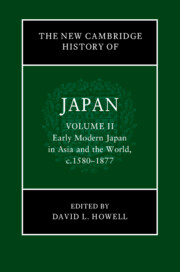Book contents
- The New Cambridge History of Japan
- The New Cambridge History of Japan
- The New Cambridge History of Japan
- Copyright page
- Contents
- Figures
- Maps
- Tables
- Contributors to Volume II
- Preface
- Frontispiece
- Introduction
- Part I The Character of the Early Modern State
- 1 The End of Civil War and the Formation of the Early Modern State in Japan
- 2 Politics and Political Thought in the Mature Early Modern State in Japan, 1650–1830
- 3 Regional Authority during the Tokugawa Period
- 4 Tokugawa Philosophy
- 5 Foreign Relations and Coastal Defense under the Mature Tokugawa Regime
- 6 The Meiji Restoration
- PART II Economy, Environment, and Technology
- Part III Social Practices and Cultures of Early Modern Japan
- Index
- References
6 - The Meiji Restoration
from Part I - The Character of the Early Modern State
Published online by Cambridge University Press: 15 January 2024
- The New Cambridge History of Japan
- The New Cambridge History of Japan
- The New Cambridge History of Japan
- Copyright page
- Contents
- Figures
- Maps
- Tables
- Contributors to Volume II
- Preface
- Frontispiece
- Introduction
- Part I The Character of the Early Modern State
- 1 The End of Civil War and the Formation of the Early Modern State in Japan
- 2 Politics and Political Thought in the Mature Early Modern State in Japan, 1650–1830
- 3 Regional Authority during the Tokugawa Period
- 4 Tokugawa Philosophy
- 5 Foreign Relations and Coastal Defense under the Mature Tokugawa Regime
- 6 The Meiji Restoration
- PART II Economy, Environment, and Technology
- Part III Social Practices and Cultures of Early Modern Japan
- Index
- References
Summary
Considered in a global context, the Meiji Restoration was a nationalist, bourgeoise revolution. At the heart of many Meiji reforms was the creation of a new national identity. The Meiji government abolished hereditary status distinctions, replaced regional institutions with a powerful central administration, and promoted the cultural and political unity of the Japanese people. The government also advanced the core institutions and mechanisms of capitalism: the alienation and partibility of land, tax collection in cash rather than kind, stock markets, bond markets, and public banking. The Meiji Restoration also needs to be considered in the context of imperialism. The Meiji leadership confronted an international order bifurcated between an elite tier of nation-states with colonial holdings and a subordinate class of subjugated colonial possessions. That context made imperialism a logical component of the Meiji state-building project. As a nascent world power, Japan required its own colonial empire.
Keywords
- Type
- Chapter
- Information
- The New Cambridge History of Japan , pp. 184 - 226Publisher: Cambridge University PressPrint publication year: 2023



